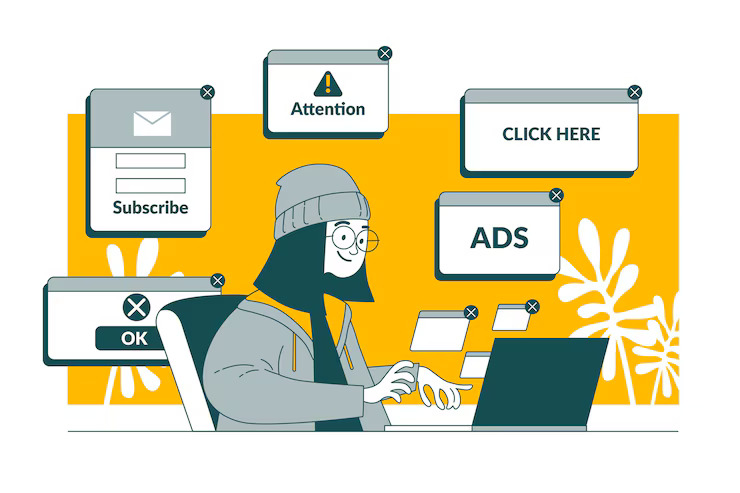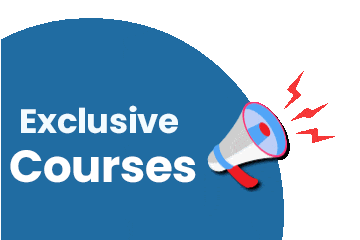
If you've recently made a website for your business or want more people to know about it, advertising can really help. There are lots of ways to reach out to new customers and boost sales, both online and offline.
To make things easier for you, we as the web design company in Delhi have listed out the main types of advertising. Once you understand them, you can pick the best one for your business and start getting more customers.
These are image-based advertisements that appear at the top, bottom, or sides of a webpage.
They have pictures or images and sometimes words. These ads want to catch your attention and make you click on them.
They can be different sizes and shapes. When you click on a banner ad, it takes you to another webpage where you can learn more or buy something.
Sometimes they show things you were interested in before, which is called targeted advertising.
Banner ads help companies show their products or services to people who are browsing the internet.
Text-based ads typically appear as sponsored links within content or in designated ad spaces on a webpage.
They are made up of words, not pictures. These ads usually look like regular links, but they're sponsored, meaning someone paid for them to be there.
They might show up in different places on a webpage, like above or below the content.
Text ads are meant to grab your attention and make you want to click on them to learn more.
They often promote products, services, or websites.
Clicking on a text ad takes you to another webpage where you can find out more about what the ad is offering.
Video ads are like short movies you watch before or during online videos. They can also pop up after the video ends.
These ads often try to tell a story or show off a product. Sometimes, you can skip them, but other times you must watch.
They can be funny, exciting, or serious. Video ads are made to grab your attention and make you remember what you saw.
They might show up on websites where you watch videos, like YouTube or news sites.
Watching a video ad might make you interested in buying what they're selling.
Interstitial ads are like big signs that show up between pages on a website.
When you finish reading or doing something on one page and click to go to the next, an interstitial ad might pop up before you get there.
These ads usually cover the whole screen, so you can't see the next page until you close the ad.
They're like short breaks between pages. Interstitial ads can show pictures, videos, or just words.
They're meant to catch your attention and make you notice what they're advertising before you move on to the next page.
Native ads blend into the content of the website, mimicking the style and format of the surrounding content to appear less intrusive.
They look like the articles or posts on a website, but they're advertisements.
You might see them mixed in with news stories, blog posts, or social media feeds.
They're designed to match the style and tone of the website, so they don't stand out as obvious ads.
Native ads aim to be less disruptive and more engaging than traditional ads. They want you to click on them and learn more, thinking they're just regular content.
But remember, they're still trying to sell you something.
These ads appear in a separate window that opens above the current browser window when a user visits a webpage or clicks on a specific element.
They can cover the whole page or just a part of it. These ads can show pictures, text, or even videos.
Sometimes, they're tricky to close, and you must search for the tiny "X" to make them go away.
Pop-up ads aim to grab your attention and make you notice what they're promoting.
But many people find them annoying because they interrupt what they're doing.
Still, some pop-up ads might offer deals or information you're interested in.
Overlay ads are semi-transparent ads that appear on top of website content without blocking the entire page.
They often have a close button for users to dismiss them.
They don't cover the whole page, so you can still see what's underneath. These ads can show up as banners or boxes with pictures or text.
Usually, they have a button to close them if you don't want to see them anymore.
Overlay ads are meant to catch your eye without blocking everything else on the page.
They want you to notice them and maybe click to learn more about what they're advertising.
These ads incorporate interactive elements such as animations, audio, or video to engage users more effectively.
Rich media ads are like mini-movies or interactive games that you might find on a website.
These ads can be super fun and engaging because they're more like entertainment than just advertising.
You might see them as small videos that play automatically or as interactive games you can play right there on the webpage.
Rich media ads want to grab your attention and keep you interested so you'll remember the product or message they're promoting.
Social media ads are like friends' posts, but they're ads. You might see them on websites like Facebook, Twitter, or Instagram.
These ads can be pictures, videos, or just words. They often show up in your feed or timeline, mixed in with posts from people you follow.
Social media ads are designed to look like regular content, so you might not realize they're ads at first glance.
They want you to engage with them by liking, sharing, or clicking.
Digital Marketing Companies and Digital Marketing Training Institute use social media ads to promote their products or services and reach more people online.
These ads promote products or services through affiliate links, where the website owner earns a commission for every sale or action generated through the ad.
Affiliate ads are like friends recommending things to you.
They promote products or services on a website, but the website owner earns money when you buy through their link.
These ads might be text, images, or both, and they often show up within articles or on the sidebar of a webpage.
When you click on an affiliate ad and make a purchase, the website owner gets a commission from the seller.
It's a way for websites to earn money by helping companies sell their products, and it's like a win-win situation because you might discover something useful.
